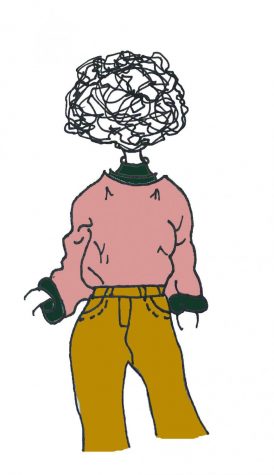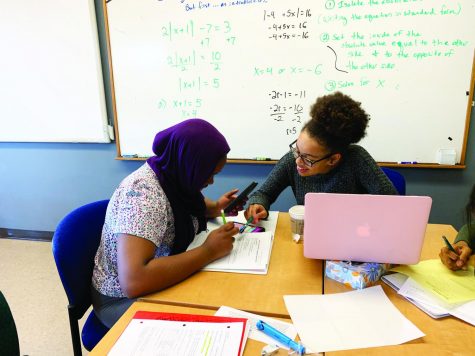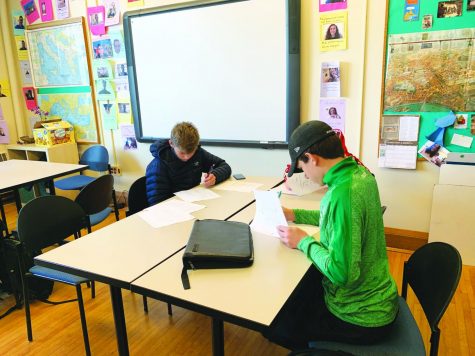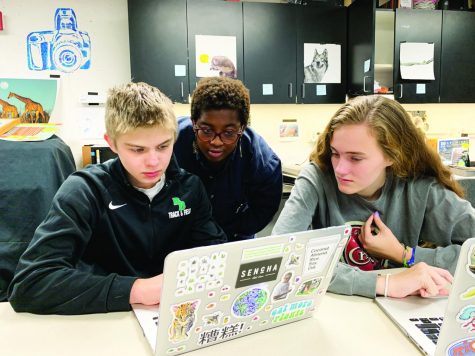Honestly Confusing
Breaking Down Definition, Experiences, and Ambiguity of Blake’s Academic Honesty Policy
November 8, 2019

“I, _______, acknowledge that academic honesty and integrity are core values at Blake and core components of a Blake School education. I understand that I am expected to abide by all policies regarding academic honesty and integrity, and I recognize that should I break the trust invested in me, I will be accountable for my actions”
— Upper School Academic Honesty &Integrity Pledge
Teachers Work to Find Teaching Moments in Instances of Academic Dishonesty
Consequences exist to help student learn from their mistake
When asked about what academic honesty means to her, math teacher Christin Winkler shares, “I think academic honesty is presenting something that reflects what you know without copying from someone else or receiving assistance from someone else.” This idea generally summarizes the role of academic honesty at Blake.
Pachao Yajcherthao, French teacher, sees academic dishonesty present itself predominantly in plagiarism and the excessive use of a translator, as well as students receiving help from tutors. In Yajcherthao’s class, the immediate consequence for a first-time offense is for her to talk to the student and the student has to redo the work, and that’s a warning…But I do have to let their dean know.

Stacy Helmbrecht-Wilson, a social studies teacher, says that when she finds someone is being academically dishonest, which in her classroom is likely cheating on a test or plagiarizing a written assignment, the consequences vary. “For cheating on formative assignments, I give a zero. For cheating on summative assignments, I usually allow a student to redo the assignment for either a 50% or a 60% grade, depending on what exactly happened with the academic dishonesty,” she explains.
Jen Vance, Freshmen Dean, sheds light on the process by saying that “There is an official communication from me to the child and the parents and 99% of the time it’s ‘this is what happened, here’s how we talk through it’ 100% of the time kids get why it’s problematic and also then [it’s] a warning in the sense of like ‘ok that’s your freebie’ the next one would have more academic consequences including potentially going to the CJB.” Vance also describes how when older students face run-ins with academic honesty issues, their dean will loop back to her to see whether or not it is a first-time offense.
Although to students it may seem that these are the only consequences of academic dishonesty, teachers find that there are more detrimental consequences that can affect students internally. For example, Winkler says, “From a human perspective, I know how crummy it feels when you cheat or steal or lie” and understand that these actions take a toll on the human psyche.
Additionally, Hembrecht-Wilson points out an aspect of academic dishonesty that creates issues for the students that do stick to academic honesty policies: “I think it also affects other students’ learning because when students are academically dishonest they’re artificially raising the bar in the classroom, and so other kids then become more stressed and have to work harder to do well which creates a much more stressful environment.”
Despite the fact that faculty members can clearly see the problems that arise from academic dishonesty, they try to make clear that mistakes like these are just that, mistakes, and they do not represent the student who makes them. Winkler says, “I like all of [my students] as people and so when I have to talk with them and sit down and say ‘look I have evidence that you cheated or plagiarized or did something that violates the academic honesty,’ I want to make sure they know I still like them. You made a mistake, [but] that doesn’t define you as a person, [and] I’m still here to support you 100%.”
This mindset stems from the fact that teachers understand the pressures that students face, and they understand that academic dishonesty often stems from these pressures being too much to handle. Vance feels that students may “lose sight of learning and really focus on that end grade or really focus on disappointing or not disappointing someone or the pressure to perform in a certain way, [and] that becomes in the forefront of their mind. I think [that] really prevents them from learning or getting the feedback in a way that can help them grow.”
Students Seek Clarifying Communication of Definition, Consequences
On paper, academic honesty has a similar definition for most students. Amaka Nwokocha ’21 describes the definition of academic honesty as “[j]ust not cheating. Doing your own work.” But, while the meaning of academic honesty seems simple, there is abundant confusion and issues between students and teachers about what this truly includes.

Amelia Reyes ’21 states, “for example, some teachers think that the learning process is talking with other people […] Other teachers will say that you can’t even talk with other people. I think the inconsistencies are problematic because some kid could get easily confused or mess up since different teachers have different expectations.” Many students find the academic dishonesty policies ambiguous since teachers have different expectations in spite of the singular set of rules listed in the student handbook. These rules are discussed in classes and homeroom for a brief period of time at the start of each school year.
Additionally, while the school tries to enforce academic honesty, students believe that cheating is a very prevalent problem that creates animosity within the student body. An anonymous source states, “it’s kinda annoying cause [the people who cheat] don’t do anything, and then they get good grades.” Although the school has countless measures to punish academic honesty, they have a difficult time catching the students that are cheating intentionally or unintentionally. Another anonymous source states, “I think [cheating] is extremely common…but I don’t tell other peoples’ business.”
While many teachers have different definitions of academic honesty, the entire student body is required to sign a document at the beginning of the year pledging academic honesty and integrity. Nwokocha states, “I think it’s problematic that we have to sign one document at the beginning of the year because teachers donít necessarily agree with it. At the beginning of the course, say what the policies are.”
When students are forced to sign one document that all teachers don’t completely agree with or miss details, it can cause sticky situations that can end up going to the Community Judiciary Board for discussion and punishment. CJB member Sam Deignan ‘20 says, “most cases of academic dishonesty, are based on miscommunication. […] [M]ost things I’ve seen are kids who don’t understand. It’s tough because they don’t see or they don’t know why they have made a mistake because most of it is a lack of communication or miscommunication.”
But amid this confusion is, as Deignan explains, the genuine desire to learn, making unclear guidelines stressful for students just trying to follow the rules. He explains that above all, “the kids here, they mean well in what they are doing.”
A PERSPECTIVE FROM THE EDITORS: Restructuring Policies Paramount to Clarification
Lack of clarity leaves abundant room for confusion, errors
While there are many different mechanisms for discipline at Blake, perhaps the most well known is the community judiciary board or CJB. The eight-member committee hears cases on a variety of issues, a common one being academic honesty. While the number of cases per year has remained about the same for the last three school years, there remains a lack of communication between CJB members, administrators, and students, leading to unnecessary confusion.

It first must be mentioned that tackling issues in a school, like academic dishonesty, is difficult for a number of reasons. Because every year the student body changes by 25% (more if counting people who transfer schools), it is almost impossible to track data and the efficacy of specific policies. By the time a new policy is implemented, the school could be made up of 250 new people. Similar issues pervade CJB as well: how can student-based ideas gain traction when a significant portion of the board graduates each year?
While these are difficult problems to solve, what is unacceptable is the uncertainty of what could send a student to CJB for academic dishonesty. In the Blake handbook, which is supposed to set up policies that determine what infractions could send someone to CJB, the information provided is vague at best. Academic dishonesty is divided up into two categories: major and minor infractions. Major infractions are defined in the handbook as “premeditated, deliberate or otherwise concerted effort to fabricate, cheat or plagiarize…distribution of answers…extensive and deliberate copying of significant sections or passages of writing from a source without attribution…[or] other examples of significant planning and/or willful deception,î and can carry penalties such as ìdetention…in-school suspension…[or] suspension or expulsion from the school.” The list of major infractions are well-defined and straightforward, but the extreme variance in punishment makes enforcing rules difficult. Obviously cases must be taken on an individual basis, which is why the handbook is set up the way it is, but ambiguity is dangerous when combined with academic dishonesty.
On their own, major infractions are clearly defined. However, the addition of minor infractions makes cases almost impossible to correctly categorize, leading to confusion and unintentional breachings of the rules. I understand why minor infractions were included: to give more flexibility in judging cases. But there is a severe issue with the minor infraction: in all 97 pages of the Blake handbook, there is not a single definition for what constitutes one. This makes it infinitely more difficult to determine the correct disciplinary action for any case because of inherent uncertainties in the classification of any action.
Ambiguity only serves to hurt students. Confusion among what constitutes academic dishonesty will only lead to unintentional transgressions of the rules. In response, I want to propose a revision of the handbook. Either define minor infractions or get rid of them entirely. This is the first step. Next would be to have CJB explain what constitutes an infraction to the school during an assembly. Students may sign a yearly slip saying that they understand the rules and consequences of academic honesty, but in reality, it is meaningless when no one knows them. Educating students is the first step to decreasing the number of academic honesty CJB cases per year.
It is imperative that Blake finds ways to better educate students on what the rules around academic dishonesty are, because as of now, the system fails the students, and students fail in the system.